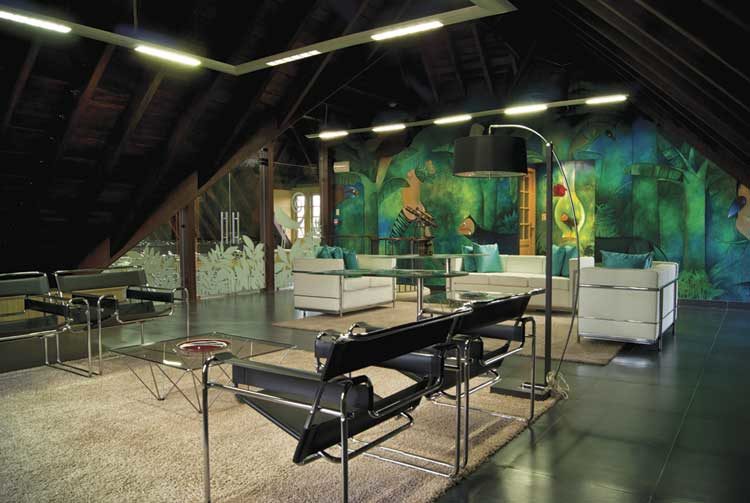Photos: Jorge Laserna
More than one story has been woven around the life and miracles of a house that marks the entry to Quinta Avenue in the Miramar district. As tales abounded about treasures hidden in its basement, ghosts that wandered through its rooms and other mysteries, the emblematic Casa de las Tejas Verdes (House of the Green Tiles) deteriorated and was on the verge of falling completely into ruin when the Havana City Historian’s Office undertook its restoration as a duty to the city’s beauty and soul.
As an example of early 20th century chalet-style domestic architecture heavily influenced by American cottages, the house has an unusual appearance, with surprising geometric shapes built into its façade, and it is topped by a steeply pitched roof with dormer windows and a small, conical tower, bringing real beauty to this spot. It is precisely because of its roof, with its exaggerated slope and its green tiles, that this house stands out it in an area that is dominated by large mansions. A front garden welcomes you up to the wraparound porch, and the house’s three stories are connected by a service staircase and another, helix-shaped one with Carrara marble steps and a wood-topped iron railing.
Like other mansions situated on this wide avenue, this house has many of the features described by authors who have studied the local architecture. In his book 500 años de construcciones en Cuba (500 years of buildings in Cuba), Juan de las Cuevas Toraya refers to common elements, such as staircases made of Italian marble and lined with at least one stained-glass window; large living rooms; libraries; rectangular dining rooms large enough to seat 12 to 24, and small, second-story waiting rooms that lead to the bedrooms.
These homes sprang up between 1917 and 1919, when the Miramar district was developed. This is described by Emma Álvarez Tabío in her book, Vida, mansión y muerte de la burguesía cubana (Lives, mansions and death of the Cuban bourgeoisie): “The attitude of living more intensely for appearance than for reality led to social behavior with a decidedly theatrical character, which in its turn required appropriate scenery to serve as a setting for the production…each family attempted to depict…its solid economic position, the importance of its place in society, its political influence and its cultural level…and the family member was required to play different roles, such as that of the generous host, the man of the world, the respectable head of the family and the solid businessman.”
The House of the Green Tiles, which was built in 1926, had a string of owners, and the distribution and use of its interior underwent a number of changes. Due to a lack of maintenance, it fell into a deplorable state, obliging the City Historian’s Office to carry out capital repairs for a full restoration.
An exhaustive report found that rainwater had leaked in and rotted the wooden components of the roof, which is made in part of reinforced concrete tiles and in part using the slab and beam system, and of the house’s entire structure. This was one of the main causes of the building’s deterioration, including the loss of moldings, rosettes and other plaster elements that adorned the ceilings and walls. The house’s brick walls also lost their external coating and became full of cracks, and signs of rust could be seen in different areas; the gardens and woodwork had also been neglected.
Given this situation and the house’s important symbolic value, the experts decided to undertake an extremely careful process of restoring it to its original state, recuperating elements that had survived and protecting floors and window frames without taking them apart. Documents and photographs were used as reference materials for this program.
Today, the House of the Green Tiles holds the work of many contemporary artists, making it even more valuable and beautiful. It has been set up so that it can be lived in, and so that it can serve as a place for explaining the city’s modern and contemporary arquitecture in El Vedado and Miramar. Paintings, photographs, sculptures, and ceramics converge at this site, where the last two pieces made by the great Pepe Rafart are on display. Other featured artists include Vicente Rodríguez Bonachea, Éver Fonseca, Ángel Ramírez, José Omar Torres, Carlos Guzmán, Eduardo Abela, Jorge Pérez Duporté, Agustín Bejarano, Luis Alberto Rodríguez, Lourdes Gómez, Manuel Cruz Igarza, Agustín Drake, Yoryana Hernández, Rita Mirabal, José Raúl Colomé, Carlos and Karen Marcoleta, Miguel Osorio, Leticia Abad, Julia González and Juan Quintanilla.
This beautiful mansion was the winner of the 2010 conservation and restoration award, and in just a short time, it has become an important center for the promotion of architecture, urban planning and interior design. With an intense cultural life, the institution hosts workshops, film series and lectures with the purpose of educating and raising awareness among all types of people about subjects such as architectural heritage, urban legends and the special features of emblematic buildings.










